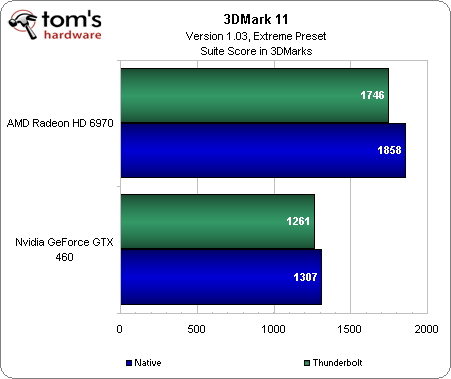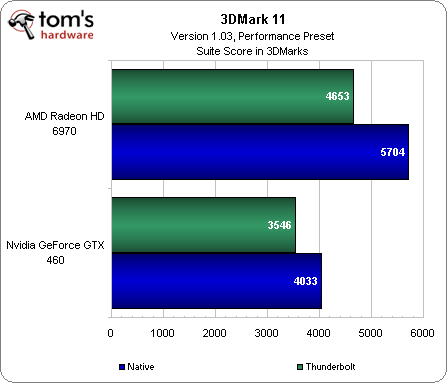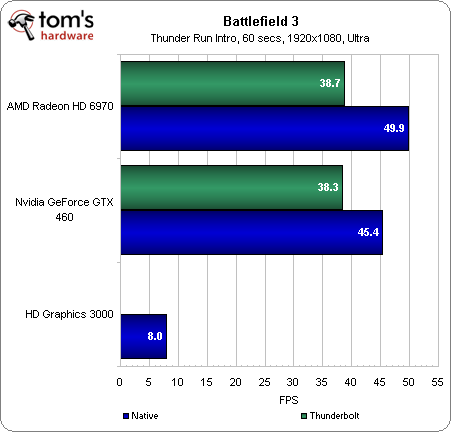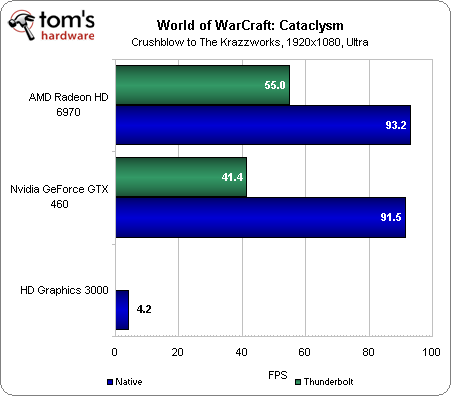Echo Express Pro: Desktop Graphics In A Thunderbolt Chassis
External Graphics Performance: Gaming
We saved the best for last. What got us excited back at CES was Thunderbolt's ability to enable external graphics on a device that simply doesn't have the physical dimensions, the thermal headroom, or a big enough power supply to accommodate a modern desktop GPU (or even a mid-range desktop GPU renamed by AMD or Nvidia to sound like a more mighty performer).
This stuff has been done before. We've seen enthusiasts use the ExpressCard standard (plus significant ingenuity) to tack add-on graphics to mobile platforms in the past. Unfortunately, ExpressCard limits you to 250 MB/s (over one PCI Express 1.0 lane). Thunderbolt gives you up to eight times as much throughput, letting more mid-range graphics cards stretch their legs.
A cursory run through 3DMark 11 using the Extreme quality preset demonstrates what we saw from the OpenCL-based benchmarks. Mainly, while there is a performance hit attributable to Thunderbolt's narrower bus, it's most quantifiable using high-end graphics cards. Dipping back to the GeForce GTX 460 reveals very little difference at all.
There's a more pronounced difference at the Performance preset, probably because we're less constrained by the performance of each GPU, meaning more data is moving between the host and not-fully-taxed graphics cards.
Nevertheless, if you're looking at the difference between integrated graphics in an Ultrabook or a slightly-degraded GeForce GTX 460 on the same machine, the minor performance loss is pretty inconsequential.
Firing up real-world gaming tests is even more telling. Intel's HD Graphics 3000 engine is simply incapable of powering through a title like Battlefield 3 at 1920x1080 using Ultra quality presets. Neither AMD's Radeon HD 6970 nor Nvidia's GeForce GTX 460 struggle, though.
You can clearly see that the higher-end AMD card is faster than the GeForce in a native setting. Limiting each card's interface bandwidth puts them on even footing, though. The good news? There's no reason to spend extra money on a more expensive board.
Get Tom's Hardware's best news and in-depth reviews, straight to your inbox.
World of Warcraft is much more platform-limited. It's probable that our Core i5-2400 running at its stock frequency is the reason AMD's Radeon HD 6970 and Nvidia's GeForce GTX 460 match each others' performance in our MSI motherboard. Pull both cards out over Thunderbolt, however, and the interface's latencies and limited bandwidth give the 6970 more of an opportunity to excel. Again, though, the more important take-away is that the Echo Express Pro paves the way for great gaming performance, whereas Intel's attempt to deliver capable graphics fall flat.
Current page: External Graphics Performance: Gaming
Prev Page External Graphics Performance: GPU Compute Next Page Thunderbolt Paves The Way For Discrete Graphics, Externally-
amuffin Well, getting a laptop that supports thunderbolt is already pretty expensive. Then, you have to get one of these which ranges from $400-$800. THEN you have to buy a dedicated card....Reply
It's pretty expensive once you add it all up :/ -
yobobjm I like it, but I see limited use for it, especially for those of us who already have large towers, and don't really want another small tower added on to that. That being said, this would make a pretty awesome home dock for a laptop, and good for those tiny desktops that intel, apple, asrock, zotac and many others make (once all of those get thunderbolt).Reply -
acku Prices will go down. Remember that.Reply
Second, it's about the cost you'd have to pay anyways for a desktop (which you need if you want to game since you can't on a vanilla ultrabook), so its more like an alternative solution for those who want a single system setup.
Cheers,
Andrew Ku
Tom's Hardware -
mayankleoboy1 any controller + the surrounding ecosystem that is this expensive cant survive much. Not being a hater, but being a realist.Reply -
acku You don't know that :). USB 3.0 was expensive when it first came out. Look at things now. Wow things have changed. Prices are substantially lower now.Reply -
Vorador2 Needs to be cheaper. That's my only serious gripe.Reply
And well, for this purpose Thunderbolt still needs to be faster to fully take advantage of the external GPU, best around 16 Gb/s since it's the speed of a 16x PCIE 3.0 slot.
Although you could potentially sidestep this issue if you use two linked thunderbolt interfaces, but then there's the problem of synchronizing data transfers (and finding a laptop with two thunderbolt interfaces...if there's any) -
Menigmand If they can make this much cheaper, I would be very interested. I prefer to game on a laptop so I can easily stow it away when I have guests over and need the dining table. An extra box would be ok, as long as it doesn't need an external display.Reply -
assasin32 Well this makes things more interesting, when the price goes down and becomes resonable within probably the next few years it may give us the ability to buy laptops and attach some reasonble GPU's to them so we can play games on them a lot better.Reply
If this was around 8 years ago I would have been all over it and had it for my laptop since I used to use that for gaming.



